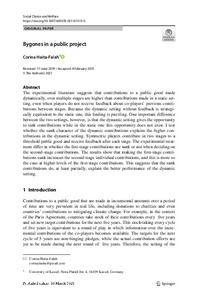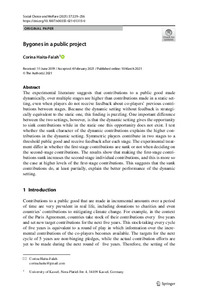| dc.date.accessioned | 2021-03-16T12:35:03Z | |
| dc.date.available | 2021-03-16T12:35:03Z | |
| dc.date.issued | 2021-03-10 | |
| dc.identifier | doi:10.17170/kobra-202103163526 | |
| dc.identifier.uri | http://hdl.handle.net/123456789/12641 | |
| dc.description.sponsorship | European Union (EU) Horizon 2020 program, action ERC-2014-STG, Project HUCO, grant number 636746; Gefördert im Rahmen des Projekts DEAL | |
| dc.language.iso | eng | eng |
| dc.rights | Namensnennung 4.0 International | * |
| dc.rights.uri | http://creativecommons.org/licenses/by/4.0/ | * |
| dc.subject.ddc | 330 | |
| dc.title | Bygones in a public project | eng |
| dc.type | Aufsatz | |
| dcterms.abstract | The experimental literature suggests that contributions to a public good made dynamically, over multiple stages are higher than contributions made in a static setting, even when players do not receive feedback about co-players’ previous contributions between stages. Because the dynamic setting without feedback is strategically equivalent to the static one, this finding is puzzling. One important difference between the two settings, however, is that the dynamic setting gives the opportunity to sink contributions while in the static one this opportunity does not exist. I test whether the sunk character of the dynamic contributions explains the higher contributions in the dynamic setting. Symmetric players contribute in two stages to a threshold public good and receive feedback after each stage. The experimental treatment differ in whether the first-stage contributions are sunk or not when deciding on the second-stage contributions. The results show that making the first-stage contributions sunk increases the second-stage individual contributions, and this is more so the case at higher levels of the first-stage contributions. This suggests that the sunk contributions do, at least partially, explain the better performance of the dynamic setting. | eng |
| dcterms.accessRights | open access | |
| dcterms.creator | Haita-Falah, Corina | |
| dc.relation.doi | doi:10.1007/s00355-021-01315-0 | |
| dc.subject.swd | Öffentliches Gut | ger |
| dc.subject.swd | Rückmeldung | ger |
| dc.subject.swd | Verhalten | ger |
| dc.subject.swd | Unterstützung | ger |
| dc.subject.swd | Experiment | ger |
| dc.type.version | publishedVersion | |
| dcterms.source.identifier | EISSN 1432-217X | |
| dcterms.source.issue | Issue 2 | |
| dcterms.source.journal | Social Choice and Welfare | eng |
| dcterms.source.pageinfo | 229–256 | |
| dcterms.source.volume | Volume 57 | |
| kup.iskup | false | |



